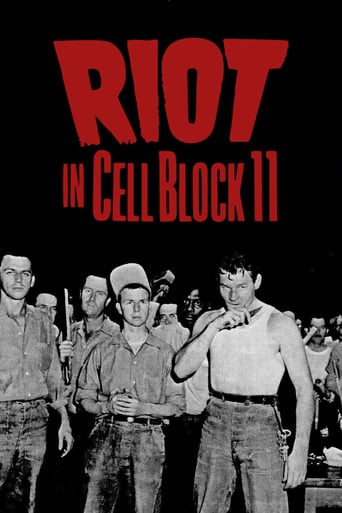Woodyanders
The angry inmates in cell block 11 led by the shrewd and fearsome James V. Dunn (superbly played by Neville Brand) stage a riot in protest to the deplorable living conditions in the prison they are incarcerated in.Director Don Siegel's trademark mean'n'lean style works exceptionally well in both maintaining an uncompromisingly tough confrontational tone throughout and keeping the gripping story moving along at a brisk pace. The use of authentic Folsom Prison locations and actual guards and convicts as extras provides an utterly convincing sense of gritty realism. The hard-hitting script by Richard Collins likewise doesn't pull any punches, with the inmates drawn in a credible manner as not all of them get along and agree with one another about the riot. Moreover, the screenplay warrants extra praise not only for its admirable refusal to paint the criminals in a too sentimental light or provide any of them with needless back stories, but also for the surprising downbeat ending with Dunn winning the battle, yet still losing the war by having thirty years added to his sentence.The strong acting by an excellent cast of sturdy and refreshingly unglamorous character actors helps a whole lot, with especially stand-out work from Leo Gordon as the unstable and dangerous Crazy Mike Carnie, Emile Meyer as the sympathetic Warden Reynolds, Frank Faylen as the rigid and uncaring Commissioner Haskell, Whit Bissell as mean chief guard Snader, Robert Osterich as venerable felon The Colonel, and Paul Frees as nervous rookie guard Monroe. Don Keefer and William Schallert pop up in small roles as reporters. Kudos are also in order for Herschel Burke Gilbert's rousing score and Russell Harlan's stark black and white cinematography. An important and provocative film.
Dalbert Pringle
In one way - 1954's "Riot In Cell Block 11" was kind of like watching a slice of Film Noir that goes to prison with no chance of parole - (Well, sort of) - Minus, of course, the femme fatale angle.As far as prison pictures go - This gritty, low-budget, tough-guy tale (though mighty tame by today's standards) still packed a substantial wallop even without a non-stop barrage of profanity and bloodshed.Filmed (in b&w) on location at Folsom State Prison, California - This particular picture is notable for being one of the first in its genre to have the disgruntled convicts manipulate the media in order to make their grievances about prison conditions known to the public.Yes. This picture featured typical, prison stereotypes. And, yes, it contained its fair share of unintentional humour, as well - But, all the same - (With its fast-paced, 80-minute running time) - It was still well-worth a view."Riot In Cell Block 11" (which was produced on a $300,000 budget) was directed by Don Siegel, who would later go on to direct Clint Eastwood in 1971's Dirty Harry.
gavin6942
Several prison inmates, to protest brutal guards, substandard food, overcrowding and barely livable conditions, stage an uprising, in which most of the inmates join, and take several guards hostage. Negotiations between the inmates and prison officials are stymied, however, by politicians interfering with the prison administration, and by dissension and infighting in the inmates' own ranks.The producer Walter Wanger (known for Ford's "Stagecoach" and Hitchcock's "Foreign Correspondent") had recently been in prison for shooting his wife's lover, and his experience there motivated this production. The film was shot on location at Folsom State Prison with real inmates and guards playing background roles."Riot in Cell Block 11" was the first film work for Sam Peckinpah, who was hired as a third assistant casting director by Don Siegel. Wanger and Siegel would team up again two years later for "Invasion of the Body Snatchers".The Criterion release is a must-have, with plenty of background information on those involved, the inspiration, related writings and an excellent audio commentary from a noted film historian.
Tim Kidner
Producer Walter Wanger wanted to make a film that exposed the appalling conditions of the prison community - and having been incarcerated himself after shooting a man he was sure was having an affair with his wife - had plenty of personal experience.The resulting 1954 80 minute gritty drama, almost an unprecedented certificate 15, even now, was directed by Don Siegel. Following a popular format in those days, it starts off with a social documentary approach, complete with concerned voice-over - that this is a public announcement, part expose, part drama. It is not based on fact, at least not from one singular incident.As you might expect, we follow prison guards (my title is the warning given to them, as they arm-up to thwart the riot), politicians and those who shape policy and of course, a handful of inmates. These provide everyday backbone; their tales are simple and uncomplicated and it's impossible to not side with them, or at least their plight. As ring- leaders take guards hostage, it becomes a nail-biting cat and mouse scenario, with Dunn (Neville Brand) producing ultimatums. Warden Emile Meyer wants negotiation, state officials want only swift force.The film is well made and tautly directed, efficient but doesn't feel rushed. The version I saw on TCM (Turner Classic Movies) had a slight green cast but was generally good. I imagine that Riot In would have been compelling and possibly controversial viewing for cinema goers. It would have found favour especially amongst those who liked the hard crime film-noir type of dramas of the day, but without any of the glamour of femme fetales.My guess is that whilst many prison dramas had been made at this point, they were character-lead and not out to socially comment. This would have been as hard-hitting as any TV '60 Minute' (etc) documentary and because it's still a good and credible film, it's still within the public domain, though is rarely shown and expensive to buy.




